Mastering Your Own Backsplash Installation
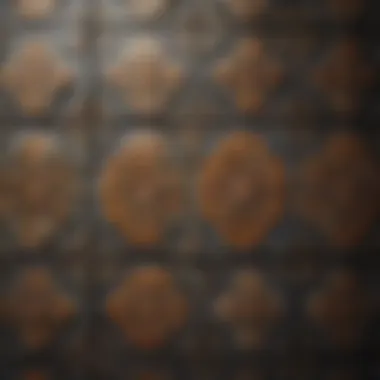
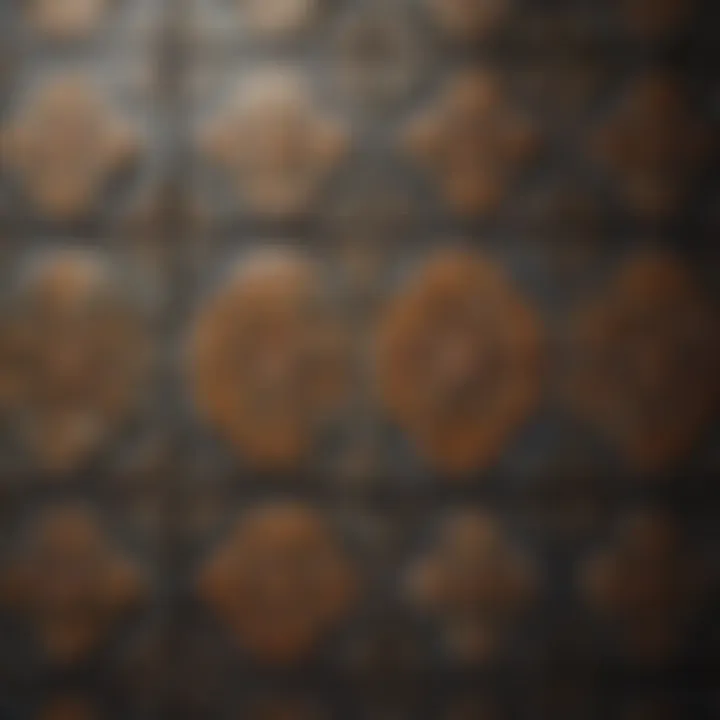
Intro
Installing a backsplash in your home can fundamentally alter the aesthetic of your kitchen or bathroom. It serves not just as a shield against spills and splashes, but as a pivotal design element that can tie together whole spaces. Whether you're looking to improve functionality or simply want to jazz up your decor, diving into the world of backsplash installation might just be the home project you need.
This guide navigates through each step of the process, focusing on the decision-making and practical know-how that will empower you to create a stunning backsplash that mirrors your personal style.
Design Inspiration
A well-thought-out backsplash sets the tone for your entire space. Getting inspiration from various design trends can provide you a solid starting point.
Trending Styles
From the chic appeal of subway tiles to the rustic charm of reclaimed wood, the choice of style is vast. Some of the more popular trends currently include:
- Geometric Patterns: Bold and striking, these tiles can create visual interest without being overbearing.
- Mosaic Tiles: These joyful arrangements of varying colors and materials can effortlessly uplift a room.
- Natural Stone: Combining durability and elegance, options like granite or marble add a touch of luxury.
Selecting a style not only depends on current trends but also aligns closely with your personal preferences and the overall design of your home.
Color Palettes
Color also plays a crucial role in how your backsplash communicates with the rest of the room. You might choose to go bold with deep blues or greens, or perhaps softer pastels for a more muted effect. Some considerations to think about include:
- Contrast: Choosing a color that stands out can create a striking effect. For instance, white cabinets paired with a dark-colored backsplash can look contemporary and fresh.
- Harmony: Alternatively, selecting shades that complement your kitchen’s existing color scheme ensures a seamless flow.
- Textures: Experimenting with different textures—like shiny, matte, or rugged surfaces—adds depth and character.
"Color is the keyboard, the eyes are the harmonies, the Soul is the piano with many strings." - Wassily Kandinsky
A good balance between these aspects highlights personal taste and can elevate the overall look of the space.
Practical Tips
Armed with a clear design vision, it’s time to roll up your sleeves for the nitty-gritty. Practical tips can make a world of difference in terms of ease and satisfaction once the job is done.
Maintenance & Care
Once your gorgeous backsplash is in place, keeping it in tip-top shape will help maintain its beauty for years. Here are a few pointers to keep in mind:
- Regular Cleaning: Use warm water and mild detergent to wipe down the surface. Steer clear of abrasive cleaners that can scratch tiles.
- Sealants: If you've chosen natural stone, be sure to apply a sealant to protect against moisture and staining.
- Grout Care: Grout can be a magnet for dirt and grime, so consider regular resealing to keep it looking fresh.
Budgeting & Planning
Planning is half the battle. When budgeting for your backsplash project, you’ll want to ensure you account for materials, tools, and any unexpected expenses. Consider the following:
- Materials: Prices can vary widely depending on your choices. Natural stone or high-end glass may cost more but can add significant value.
- Tools: You may need items like tile saws or adhesive, so consider renting to save costs.
- Time Investment: Factor in not just the budget but also your own availability to complete this project without rushing it.
With these insights and inspirations, you now have a solid foundation to start planning your very own backsplash.
Be prepared to embrace the journey of creativity, learning, and even a bit of problem-solving along the way.
Preface to Backsplashes
A backsplash in the kitchen is more than just a mere protective barrier against splashes and stains. It serves as a canvas, showcasing personal style while ensuring hygiene and convenience. The topic of backsplashes is essential for homeowners, as this element can dramatically transform the ambiance of a kitchen or bathroom. Hence, understanding the fundamentals behind choosing, designing, and installing a backsplash lays the groundwork for a successful home improvement project.
Defining the Backsplash
In its simplest form, a backsplash is a vertical extension of the countertop, typically behind sinks, stovetops, and workspaces. It acts as a shield against water, grease, and other substance spills that could otherwise penetrate the walls. Backsplashes come in various materials and styles, ranging from classic ceramic tiles to contemporary glass panels. The definition of a backsplash extends beyond its protective function; it embodies culinary artistry and interior design.
"A backsplash is not just about function; it's about the statement it makes!"
The choice of material plays a vital role in defining the backsplash's overall impact. Homeowners may opt for ceramic tiles due to their durability and ease of cleaning. In contrast, some might prefer the luxurious appeal of natural stone or the sleekness of stainless steel. Each choice carries its own vibes, ushering in distinct aesthetics and practicalities.
Historical Overview of Kitchen Backsplashes
Delving into history, we uncover that the concept of backsplashes dates back centuries, with their earliest renditions appearing in grand kitchens of the Roman Empire. These structures were often crafted from terracotta to protect walls from cooking splatters. Fast forward to the Renaissance period, intricate mosaics emerged, elevating backsplashes into works of art rather than just functional elements.
As we moved into the 20th century, the mid-century modern aesthetic brought a revival in using vibrant colors and innovative materials like glass and metal. Today, backsplashes reflect personal tastes and current design trends, embodying influences ranging from sleek minimalism to rustic charm. The evolution of backsplashes holds a mirror to broader changes in kitchen designs, showcasing how our culinary spaces adapt over time to the needs and preferences of homeowners.
Understanding these subtle transformations offers valuable insight into today’s choices, allowing for a well-informed approach as one embarks on their backsplash project.
Importance of a Backsplash
When it comes to renovating or freshening up a kitchen, one might overlook the small details that pack a punch. A backsplash is more than just a decorative element; it stands at the junction of functionality and aesthetics. Understanding its importance shapes not only a kitchen’s operation but also its overall vibe.
Functional Benefits
A backsplash serves several practical purposes in any kitchen. First off, it protects the walls from splashes, stains, and moisture from cooking. Think about it: every time you sauté vegetables or boil pasta, there’s a good chance of food particles and water making a mess. These splashes can lead to damage if left unchecked. Installing a backsplash mitigates these concerns, offering a protective barrier.
Furthermore, it makes cleaning a breeze. With just a quick wipe down, you can remove any stains that accumulate over time. This is especially true for modern materials like glass or ceramic tiles, which can resist stains better than paint or bare drywall.
In adding insulation, a backsplash can also play a vital role, preventing heat from damaging your walls as you cook on the stovetop. Not only does this extend the longevity of your wall, but it can also be a fire safety consideration, providing an extra layer of protection where there might be direct heat exposure.
Aesthetic Contributions
The visual impact of a backsplash cannot be overstated. It allows homeowners to express their personal style, often acting as the focal point of the kitchen. Whether you opt for a bold, intricate pattern or a simple, clean design, the choice in color, material, and layout can transform the kitchen’s atmosphere.
- Color: Light shades can make a small kitchen seem larger, while dark colors can add warmth and coziness. Selection allows you to emphasize or complement cabinetry, countertops, and flooring.
- Materials: From traditional ceramic to decadent marble, the material can dramatically change the ambiance. For instance, while a subway tile adds a classic touch, a rustic wood backsplash can infuse a country charm.
- Patterns: The way tiles are laid can introduce elements of surprise. Herringbone, stacked, or even a brick pattern can add architectural interest in ways paint simply cannot.
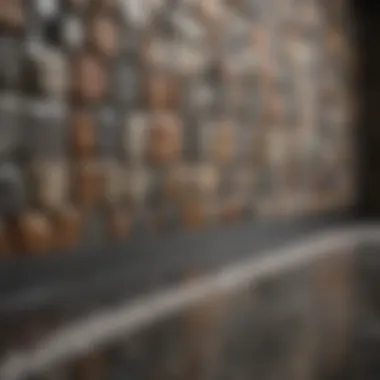
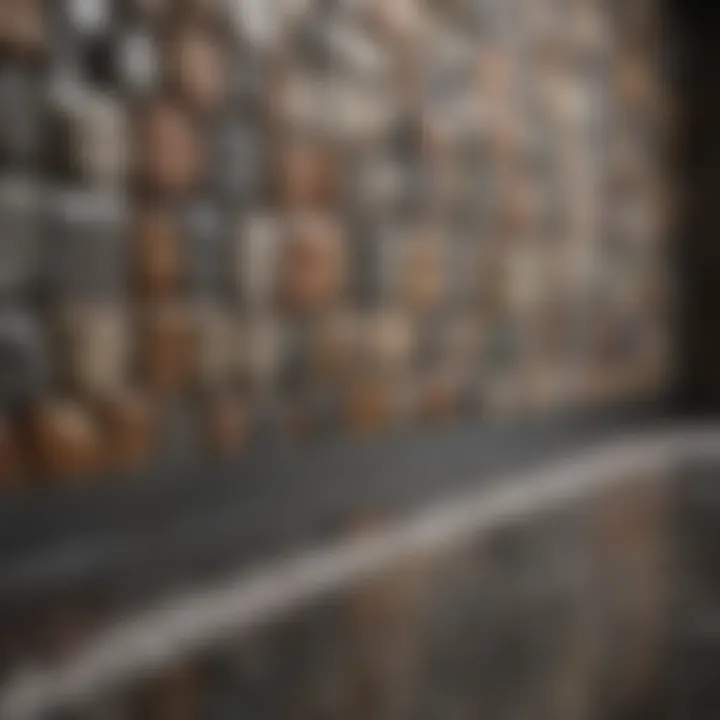
The visual appeal of a kitchen has far-reaching effects, influencing the mood and perception of space. Individuals entertain, dine, and gather in this part of the home. Therefore, a well-designed backsplash can contribute significantly to making this space more inviting.
With the right backsplash, you’re not just enhancing the kitchen’s usability. You’re creating an experience—an environment where every meal becomes memorable.
Materials for Your Backsplash
When considering a backsplash, the materials you choose speak volumes about not just the look, but also the functionality and durability of your space. Selecting the right material is a dance between style and substance. Each type of material brings its own flair, yet understanding the nuances can have a big impact on your project’s outcome.
Tile Options
Ceramic Tiles
Ceramic tiles have been a go-to for backsplashes for quite some time. One of their distinguishing features is their versatility. They come in a zillion colors and designs. This versatility makes them a popular choice for anyone looking to inject some personality into their kitchen or bathroom.
Ceramic tiles are known for being affordable and easy to find in home improvement stores, which is a plus for budget-conscious homeowners. They are generally resistant to stains and moisture, though care should be taken around sharp objects to avoid chips. A unique aspect about ceramic is how it can mimic the appearance of more expensive materials, giving that high-end look without breaking the bank.
However, they can be quite cold and hard underfoot; a slip here could lead to an unwanted bump on the head. They also require grout, which can be troublesome to maintain, especially in heavily used areas.
Glass Tiles
Glass tiles are like the shiny new trend in the world of backsplashes. Their light-reflecting qualities give any space an added depth, making kitchens feel brighter and more spacious. A striking characteristic is their easy maintenance; they do not stain and can be wiped down with minimal effort.
It's important to note that glass tiles are often pricier than ceramic and can be more challenging to install due to their fragile nature. They can chip if not handled carefully, but the payoff is worth it for many people – the glossy finish creates a modern and fresh aesthetic.
An additional feature is the color choice; many glass tiles are available in transparent hues, which allow underlying colors to peek through. This lets homeowners express their creativity while maintaining a clean look.
Stone Tiles
Stone tiles, like granite or marble, can bring an earthy, organic appeal to your space. They give off a sense of luxury and stand out as a classic choice. The unique veining and imperfections in stone tiles mean that no two tiles are identical, which can add character to the overall design.
The downside? Well, stone tiles can be expensive and may require sealing to protect against stains and moisture. They also tend to be heavier, which may necessitate more secure mounting materials, not to mention that the installation process could take longer. Nevertheless, many homeowners find the natural beauty and durability make the investment worthwhile.
Alternative Materials
Wood
Using wood for a backsplash can bring warmth and charm to any kitchen. It creates an inviting atmosphere, perfect for a cozy home. Wood panels can easily be customized with stains or paints to match existing decor, which is a key benefit for those looking to maintain a cohesive look.
Despite being attractive, wood requires considerable upkeep. It is susceptible to moisture, and thus, tends to demand regular sealing and care to prevent warping or mildew. Ultimately, wood is a great choice for those who appreciate a rustic vibe but be advised that it comes with maintenance responsibilities.
Metal
When it comes to modern aesthetic, metal backsplashes can turn heads. Stainless steel or copper might not be the first material that comes to mind, but they offer an eye-catching finish that can make cooking feel more high-end. Metal is lustrous, durable, and can handle the heat, which is essential in a busy kitchen environment.
However, the downside to metal is the cost and potential for denting. Kitchen accidents can leave you with unsightly marks, and even though some find that adds character, it may not suit everyone's taste. Additionally, fingerprints can become a nuisance, requiring regular polishes to keep things looking sharp.
Vinyl
Vinyl backsplashes are on the rise as a budget-friendly option that comes in a vast array of colors and patterns. They are lightweight, easy to install, and can be an excellent choice for renters who want to jazz up their kitchens without a long-term commitment. The hassle-free aspect of vinyl is appealing; cleanup is as simple as soap and water.
Nonetheless, it may not hold up as well against heat or high moisture levels compared to ceramics or metals. Owners should be cautious with hot appliances, as these could warp the material over time. Vinyl’s affordable price can be a double-edged sword as lower durability might not make it a wise investment long-term.
Design Considerations
When taking on the task of installing a backsplash, design considerations play a crucial role in ensuring that the final product not only serves a functional purpose but also enhances the overall aesthetic of the space. The design of a backsplash can significantly influence the ambiance of a kitchen or bathroom. From style choices to color schemes, each decision affects how the backsplash integrates with the rest of the decor.
In the journey of executing your own backsplash, being mindful of design choices helps create a cohesive look that reflects personal taste while considering practicalities such as durability and maintenance. Investing time in this phase lays the groundwork for a successful installation that brings both beauty and utility in equal measure.
Choosing a Style
Your choice of style for the backsplash sets the tone for the entire room. Each style presents unique traits that can either complement or clash with existing elements of your home. Below are three predominant styles often chosen for backsplashes, each with its own set of characteristics and appeal.
Traditional
The traditional style evokes a sense of timelessness. It often features classic materials such as ceramic or natural stone, with designs that include intricate patterns or rich textures. The key characteristic of traditional backsplashes is their ability to create warmth and a sense of comfort in a space.
One unique feature of traditional backsplashes is the use of intricate tile layouts, like herringbone or basketweave, which imbue a sense of craftsmanship. This style is beneficial for homeowners looking to create a more inviting, homey atmosphere. However, it may not resonate as well in modern or minimalist spaces, which could lead to a disjointed look if not planned carefully.
Modern
In contrast, modern backsplashes lean towards simplicity and sleek lines. The hallmark of modern design is its use of materials like glass, metal, or even matte-finished tiles. They often present bold colors and minimalist designs, which contribute to the spacious feel of a contemporary kitchen.
A standout feature of modern backsplashes is their seamless integration with the overall aesthetic, offering a chic and polished finish. This style is a popular choice for those wanting a fresh, airy vibe. However, the minimal approach can sometimes appear cold or impersonal, depending on the surrounding decor.
Transitional
The transitional style acts as a bridge between traditional and modern. This approach blends elements from both styles, allowing for creative expression while still maintaining functionality. A transitional backsplash might feature classic materials like subway tiles but in modern colors or configurations.
The key characteristic of transitional designs is their flexibility; they can fit in with various decor themes. This versatility makes it a beneficial choice for homeowners who want a style that won’t clash with future renovations. The downside might be that it can be harder to nail down a cohesive vision, as tradition and modernity may sometimes pull in different directions.
Color Schemes and Patterns
The color scheme and patterns chosen further refine the design of the backsplash. Well-considered hues can either highlight or downplay features in the room.
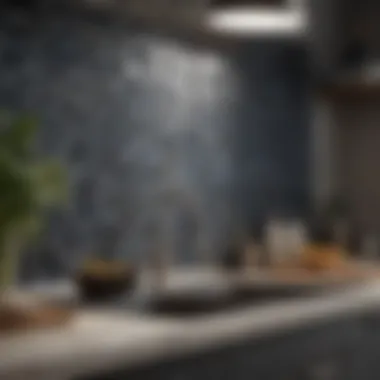
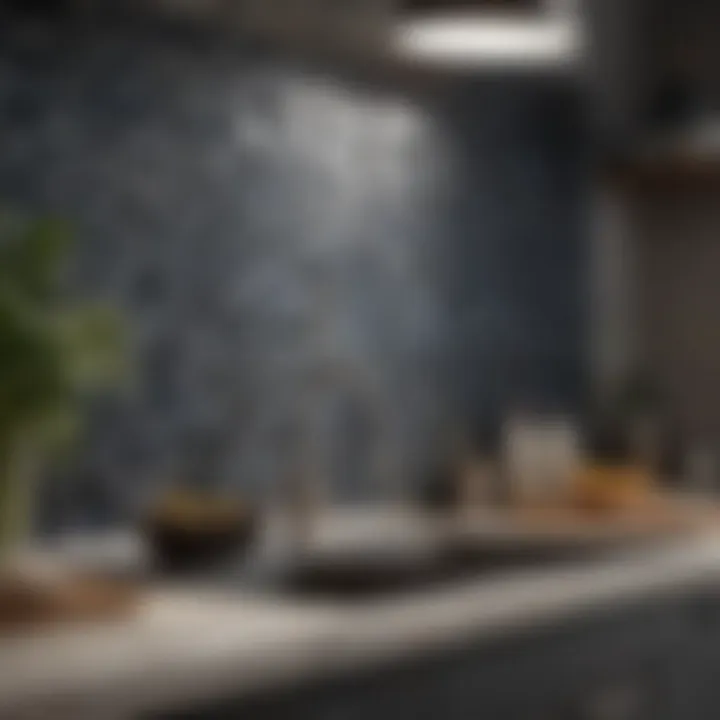
- Solid Colors: Create a uniform and clean look, making small spaces appear larger.
- Bold Patterns: Inject a dose of drama and can serve as focal points but require careful coordination with surrounding elements to avoid overwhelming the eye.
- Contrasting Colors: Can define the area and add character, yet may also pose a risk of clashing with existing elements.
In wrapping all these design considerations together, it is essential to engage with each aspect carefully, ensuring they resonate with your personal style while remaining functional.
The right design choices can elevate a simple kitchen into a stylish focal point of the home. After all, a creatively executed backsplash is not just a task; it’s a chance for self-expression and refinement.
Preparation for Installation
Preparation is a cornerstone in the process of installing a backsplash. It goes beyond merely gathering materials; it’s a mindset that gears you up for the entire project. This phase ensures you have everything you need at your fingertips, creating an inviting environment for creativity to take flight. Ready yourself for success by understanding what it means to be thoroughly prepared. It’s not just about avoiding mishaps—though that's certainly a perk—but also about enhancing the quality of your work and your overall experience.
Gathering Tools and Supplies
Gathering the right tools and supplies might feel like collecting treasures before embarking on an expedition. Each item plays its role, ensuring the journey ahead unfolds smoothly. Let's explore the essentials:
Adhesives and Grout
Adhesives and grout act as the backbone of your backsplash installation. The right adhesive not only holds everything in place but also provides durability against moisture and daily wear. One popular choice is thin-set mortar, which offers excellent bonding properties and is suitable for various tile types.
Adhesive characteristics include its ability to withstand water, temperature fluctuations, and time. It's paramount. A robust adhesive prevents tiles from shifting, preserving the aesthetic you've worked hard to build. Grout then fills the gaps, tying the whole backsplash together while protecting against moisture and stains. Simple cement grout is often favored for its resilience, while epoxy grout provides additional strength and is less prone to staining.
However, each adhesive and grout type brings its own unique features. Thin-set may require longer drying times, while epoxy can be trickier to apply yet offers a high resistance to chemicals. Understanding these nuances prepares you for the decisions ahead, ensuring your backsplash stands the test of time.
Cutting Tools
Cutting tools are indispensable in the installation arsenal. The right tools make a world of difference when it comes to achieving clean, precise cuts, especially around edges and corners. A tile cutter or a wet saw can dramatically enhance your ability to work efficiently.
A tile cutter is simple to use and is perfect for small projects. Imagine pressing down on the lever and scoring the tile with a clean break. It’s satisfying, truly. On the other hand, a wet saw utilizes water to minimize dust and provide smooth cuts, making it more suitable for handling heavier, tougher materials like porcelain.
When weighing the pros and cons, consider aspects like the scale of your project and the type of tiles you're using. A wet saw may be an investment but may save time and effort in larger jobs. Choosing cutting tools wisely can prevent frustrating mishaps that often occur from inadequate equipment.
Measuring Tools
Measuring tools are the unsung heroes of any installation project. Accurate measurements prevent costly mistakes and ensure each tile fits snugly into its designated space. Without proper measurements, you might find yourself in a pickle, with misplaced tiles or uneven patterns.
A dependable tape measure is essential, as is a level to ensure your tiles don't end up on a slant. A square can help get those perfect angles right and a chalk line can lay down guides to streamline the process, ensuring consistency. The right measuring tools not only save time on iterations but help maintain the visual appeal of your design.
The twist is that mismeasurements can lead to tears, but a little diligence in gathering these tools safeguards your project and enhances your capability to execute a professional installation.
Measuring the Space
Before diving in, measuring the space is a critical step one should never skip. It’s akin to plotting a map before a grand adventure; it directs your focus and resources correctly. Begin by measuring the height and width of the area that requires a backsplash. Make notes, and inwidth, consider any nooks and crannies that might complicate installation.
Using a notepad or digital app will streamline your input. Draw a quick sketch if needed. Keeping a precise visual guide can go a long way in ensuring that when it’s time to place those tiles, you’re not left out in the cold, unsure of your next move. Thorough measuring translates into a polished, professional look that truly elevates your kitchen.
Installation Steps
The installation steps are crucial in ensuring that your backsplash not only looks great but functions effectively as well. It's where the artistry of design and the practicality of application merge. Taking the time to prepare and follow a systematic approach will save you time and frustration down the line. Consider these steps to be your roadmap, guiding you through the intricacies of the project with a minimalist mindset.
Preparing the Wall Surface
Before diving headfirst into installing your backsplash, the wall surface preparation cannot be overstated. This step lays the groundwork for a successful and long-lasting installation. A properly prepared wall ensures that the adhesive bonds well, preventing tiles from falling off later.
Start by cleaning the wall thoroughly to remove any grease, dirt, or dust, especially if it's in the kitchen. Using a mixture of warm water and mild detergent is often effective. Once clean, dry the surface thoroughly. Any moisture left can weaken the adhesive’s grip, leading to future issues.
Next, check for any irregularities or damage on the wall. If you find any, consider using a wall compound to fill in imperfections. A smooth, even surface will create a surface on which tiles can adhere successfully. In some cases, applying a primer might also be beneficial, especially if you're working with laminate or shiny finishes.
Applying Adhesive
After ensuring a smooth wall surface, it's time to dive into applying the adhesive. This step is vital as the choice and application method of your adhesive directly impact the durability of your backsplash.
Choose an adhesive that is compatible with your chosen tile material. For instance, a thin-set mortar is commonly used for ceramic or stone tiles, while a mastic adhesive might be more appropriate for lighter tiles. Use a notched trowel to spread the adhesive evenly across the wall. The trowel's notch size will depend on the tile size, so check the manufacturer's recommendations. Ensure to hold the trowel at a consistent angle while applying—this will create an even bed of adhesive, strengthening the bond.
Remember that you only need to apply adhesive for a small section at a time. This prevents it from drying before you can place your tiles, which kinda brings us to the next crucial step.
Placing Tiles
Now comes the fun part—placing the tiles! This step allows you to manifest your design vision. Start in the center of the wall or from a straight edge, working your way outward. This will help to ensure symmetry and that your patterns align beautifully.
As you lay each tile, gently pressing down will help to secure it into the adhesive. Don’t forget to use spacers between tiles to maintain consistent grout lines. If you’re feeling adventurous, create a design pattern that speaks to you; perhaps a herringbone for drama or a simple grid for a modern take. Be wary at this stage; the adhesive does not set instantly, so you can still adjust tiles slightly if you catch a mistake early.
Grouting and Finishing
With your tiles perfectly placed and secure, it's time for the final touch—grouting. This step fills the gaps between tiles and adds the finishing touch to your backsplash. Mix your grout according to the manufacturer’s instructions, ensuring consistency akin to peanut butter. Applying grout is where your patience pays off. Using a rubber float, spread the grout over the tiles at an angle, pressing it firmly into the gaps. Afterward, use the edge of the float to remove excess grout, taking care to avoid displacing it from the spaces you just filled.
Once the grout settles, lightly moisten a sponge and wipe down the surface of the tiles to eliminate any grout haze. This might take a bit of elbow grease, but it's key to keeping tiles looking fresh and new. Lastly, once fully dried, consider applying a sealant to protect the grout from stains or moisture—a little precaution goes a long way!
"Properly executed installation steps not only reflect craftsmanship but also assure a lasting impression!"
Common Challenges and Solutions
When embarking on a home improvement project like installing a backsplash, it’s important to prepare for the hurdles that might pop up along the way. Recognizing and addressing potential challenges isn't just a convenience; it's a crucial part of ensuring a seamless installation. Common challenges can range from uneven walls to difficulties in achieving a level finish. Tackling these issues head-on can save you time, effort, and resources and even enhance your overall experience during the project.
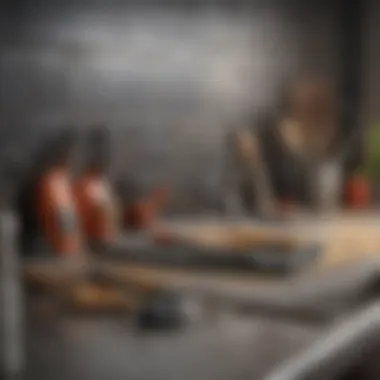
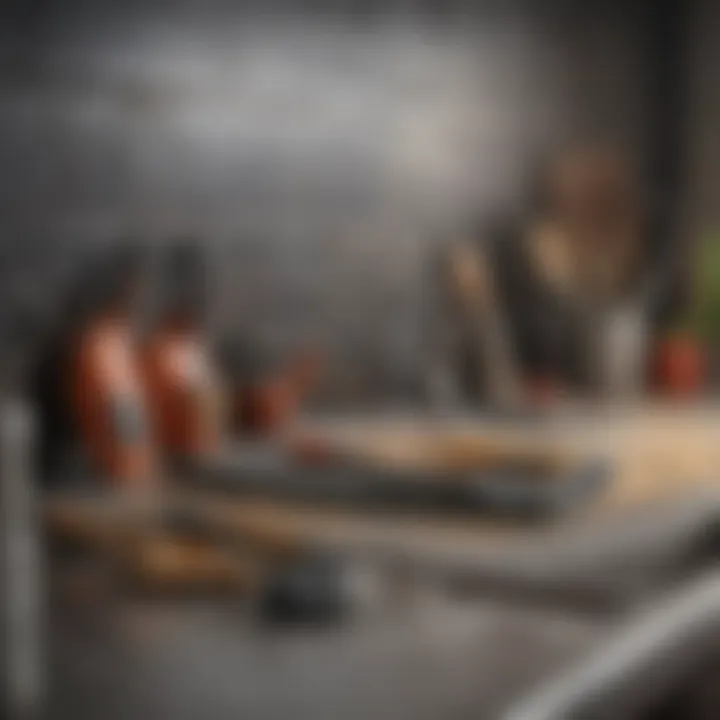
Dealing with Irregular Walls
One of the more frustrating aspects of backsplash installation can be the condition of your walls. Many homes, particularly older ones, might have walls that aren’t perfectly straight or even .
Before you begin laying any tile, it’s essential to assess the wall surfaces. Take a level and see where corrections may be needed. Here’s what you can do if you find irregularities:
- Use Shims: They’re great for adjusting your tile surfaces on uneven walls. By slotting shims behind the backing board or directly underneath your tiles, you can bring everything up to the same level.
- Tile Saws and Cutters: When a wall isn’t straight, it often calls for custom-cut tiles. A snap cutter or wet saw can help create the intricate shapes needed to fit snugly against the wall.
- Fiberglass or Drywall Paneling: As a last resort, consider covering the wall with paneling to create a smoother surface before tiling. While it may seem like extra work, the payoff is a professional-looking finish.
Investing some time in properly preparing your wall can mean the difference between frustration and success. This small effort can also enhance the overall look of your kitchen or bathroom, making it a worthwhile step.
Ensuring Level and Alignment
Once you’ve got your walls sorted out, the next common challenge is keeping everything level and aligned. Nothing detracts from a beautiful backsplash like crooked tiles or uneven grout lines.
To avoid these pitfalls, here are a few tips to keep in mind:
- Use a Laser Level: These tools project a straight line across your installation area and can help you gauge where your tiles should be placed. They’re user-friendly and can significantly improve accuracy.
- Start from a Center Point: For aesthetic balance, begin your tile layout from the middle of your wall. This ensures that the tile sizes are the same on each side, which can help give a more cohesive look.
- Maintain Consistent Spacing: Utilize tile spacers to keep your tiles evenly spaced. This helps not only in achieving a straight line of grout but also in ensuring the tiles don't slide around as they set.
The level of precision you maintain during this step can elevate your project from a simple DIY to a showcased piece of art in your home.
With a bit of careful preparation and an eye for alignment, you can handle common challenges that arise during backsplash installation with ease. Remember, patience is key, and every step taken to rectify these issues can result in a stunning backsplash that enhances the beauty of your living space.
Maintenance of Your Backsplash
Caring for your backsplash is not just about keeping it looking good; it’s also about ensuring its longevity and functionality. A well-maintained backsplash can retain its charm and utility for years, acting as a shield against moisture and stains in your kitchen or bathroom. When you take the time to attend to your backsplash, what you’re really doing is investing in the overall aesthetic and practical value of your home.
Why Maintenance Matters
Regular maintenance helps avoid costly repairs and can prevent the slow degradation that often occurs unnoticed until it’s too late. Kitchen backsplashes, in particular, are prime candidates for wear and tear due to cooking splatters, steam, and even the occasional rogue piece of pasta sauce.
Some specific considerations include:
- Prevention of Mold and Mildew: In areas where moisture is present, like kitchens and bathrooms, neglecting upkeep could result in mold growth. This can compromise the health of your home.
- Preserving Aesthetic Appeal: A clean backsplash enhances the beauty of your space. Grimy tiles or discolored grout can detract significantly from your design.
- Extending the Lifespan: Simple cleaning and minor repairs prolong the life of your tiles, saving you time and money in the long run.
Each aspect of maintenance plays a critical role in supporting the overall integrity of your work—here’s how to do it.
Cleaning Techniques
Keeping your backsplash clean isn’t just about appearances; it's about protecting the material from grime buildup that can cause damage over time. Here are some practical cleaning techniques:
- Gentle Cleaning Agents: Use mild soap mixed with warm water for day-to-day cleaning. Avoid harsh chemicals that could tarnish the finish.
- Soft Cloths or Sponges: Opt for non-abrasive cloths to wipe down surfaces. A simple sponge dipped in soapy water works wonders without scratching the surface.
- Grout Maintenance: Grout can often attract dirt. A mixture of baking soda and water can help; apply it with an old toothbrush to lift away stubborn stains.
- Vinegar Solution: For glass or ceramic tiles, a diluted vinegar solution can effectively dissolve mineral buildup and restore shine. Just make sure it’s safe for your specific tile type before using it.
"Regular cleaning not only preserves the aesthetics of your backsplash but also protects your investment in your home."
Repair and Restoration
Despite your best efforts, wear and tear can occur. Quick action taken during repairs can prevent larger issues. Here’s how to handle minor damage:
- Assess the Damage: Start by determining the extent of the damage. Small chips or cracks typically don’t require complete replacement.
- Grout Touch-Up: If the grout has cracked or become discolored, re-grouting is a simple task. Remove the old grout and apply a new layer using a caulking gun for precision.
- Replacing Tiles: For cracked tiles, carefully remove the damaged tile. Ensure the surrounding area is clean and smooth before applying a new tile with adhesive.
- Sealants and Finishes: After cleaning and repairs, consider applying a sealant to porous materials like stone tiles to protect against future spills and stains. It’s a small step that can make a big difference!
Inspiration and Trends
In the realm of interior design, the backsplash often serves as a crucial marker of personal style and a vital structural element in kitchens and bathrooms. As one seeks to enhance these spaces, understanding current inspirations and trends can be the key to crafting environments that resonate not just with aesthetics but with the function too. Homeowners can transform a mundane cooking area into a stylish culinary hub, or a simple bathroom into a spa-like retreat, all through thoughtful backsplash choices. With that in mind, let’s take a closer look at what’s trending right now, and how incorporating these ideas can benefit your next home improvement project.
Current Design Trends
Today's homeowners are gravitating towards backsplashes that reflect individuality while also serving practical needs. A few notable trends have emerged:
- Bold Patterns: Many people are becoming more daring with their design choices, opting for zany geometric shapes or intricate mosaics. These options allow for a personalization that can make a strong statement.
- Natural Materials: There’s a noticeable shift towards elements like slate, marble, or wood, providing warmth or sophistication to a space. Such materials are not just appealing but can be easier to maintain if sealed correctly.
- Subway Tile Evolution: While traditional subway tiles remain popular, variations in size, color, and application are now trending. Homeowners are tilting them at angles or mixing sizes to create an edgier look.
These trends, noted from various design portfolios, can breathe life into kitchens and bathrooms, making spaces much more appealing to both residents and guests.
Innovative Design Ideas
Embracing creative approaches can help homeowners customize their backsplashes. Here are some innovative ideas that push the envelope:
- Backlit Panels: Utilizing LED lighting behind translucent materials or tiles creates a stunning glow, making nighttime gatherings more intimate.
- Mixed Materials: Don’t shy away from combining different materials such as tiles with metal or wood frames. This blend endorses a layered approach that adds depth.
- Personalized Graphics: You can even consider using custom prints or decals that represent your interests—like vintage food ads or abstract art—imprinting your personality on the space.
Innovation doesn’t just mean incorporating trendy elements; it means creating a space that tells your story.
As the design landscape continues to evolve, these inspirations could very well lead to a backsplash transformation that feels both timeless and on-trend, all while ensuring you’re happy with the space you live in. Ultimately, the integration of these elements fosters an environment that is neither just functional nor solely aesthetic—it is a reflection of who you are as a homeowner.
Finale
In wrapping up this extensive guide, it’s essential to underscore the multifaceted significance of installing your own backsplash. This isn't just about functionality; it's a fusion of creativity and necessity. A backsplash serves as a protective barrier, safeguarding your walls from grime and splashes, while also contributing a vital aesthetic punch to your cooking or entertaining space.
Recap of Key Points
Implementing a backsplash entails several crucial steps:
- Understanding Backsplash Functions: A backsplash protects your walls and own personal touches to your kitchen or bathroom.
- Selecting Materials: Choosing from tiles, wood, metal, or vinyl can make a big difference in both look and durability.
- Design Choices: Styles vary between modern, traditional, or transitional, making this step a personal reflection of your taste.
- Prepping for Installation: It’s not just about plopping tiles down; the preparation phase is critical.
- Taking on Common Hurdles: From irregular walls to ensuring everything aligns perfectly, knowing how to tackle these is key.
- Maintenance Practices: Keeping the backsplash looking fresh requires a bit of effort, but it's worth it for longevity.
These points serve as the backbone of your backsplash journey, blocking out uncertainty and leading to a space that feels uniquely yours.
Encouragement for Homeowners
For homeowners sitting on the fence about whether to tackle this project, consider this: every stroke of adhesive and placement of a tile is not just work—it's a chance to express yourself. Don't underestimate the skill you possess. Many have walked this path with little more than a smartphone and a sense of adventure. Whether your style leans towards the classic, modern, or a quirky mix, remember that the journey is just as rewarding as the destination.
Engage in DIY not just for the end result, but for the pride that comes with every element of your design. You might find it more enjoyable than you thought. And remember, it’s okay to ask for help! Use your community, like forums on reddit.com or groups on facebook.com, to gather advice and motivation. The kitchen is often called the heart of the home; why not decorate its walls with a reflection of your personality?
Whether you’re flipping through design trends or measuring out your materials, each step is an opportunity to learn and grow. So stock up on those tools, roll up your sleeves, and dive right into this creative venture.















